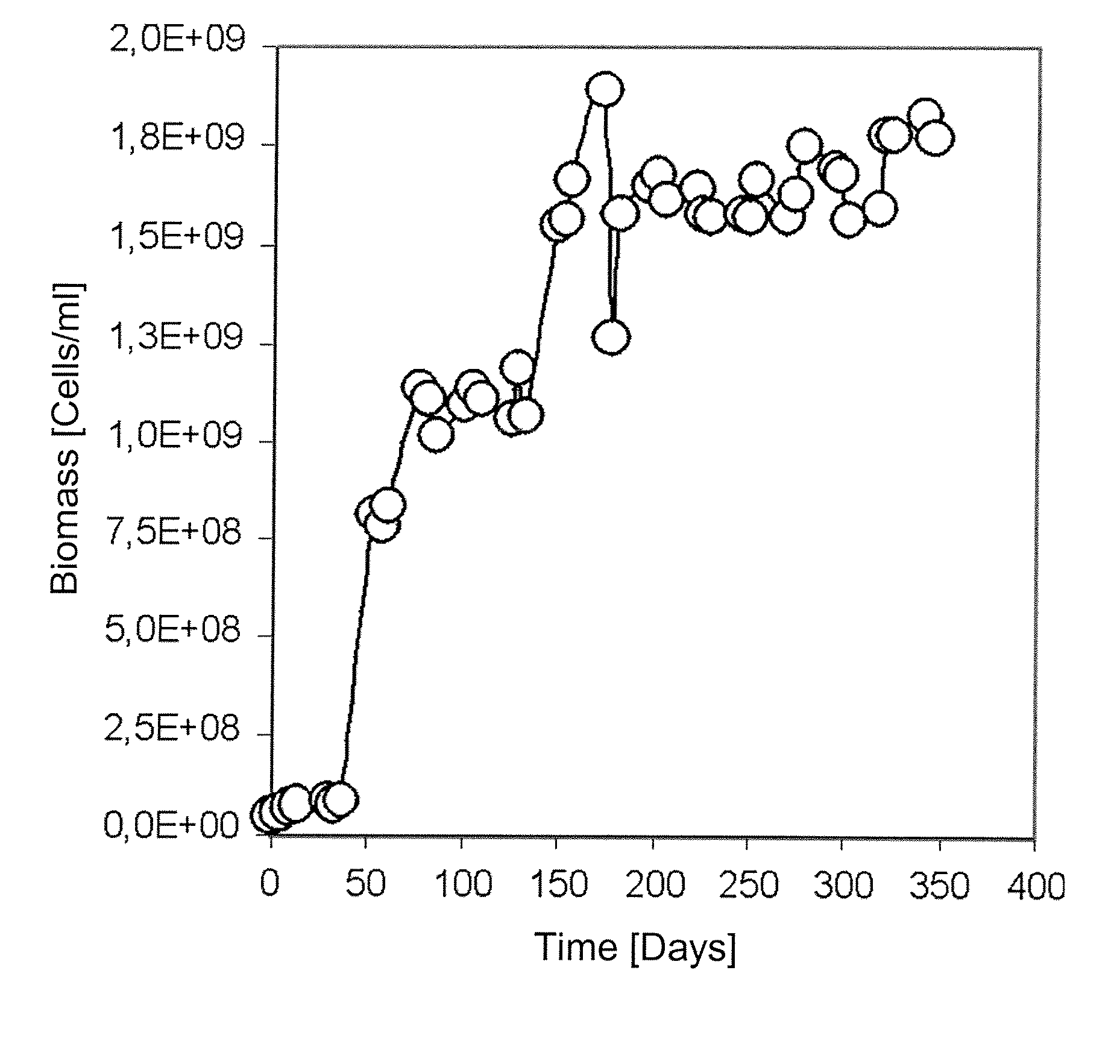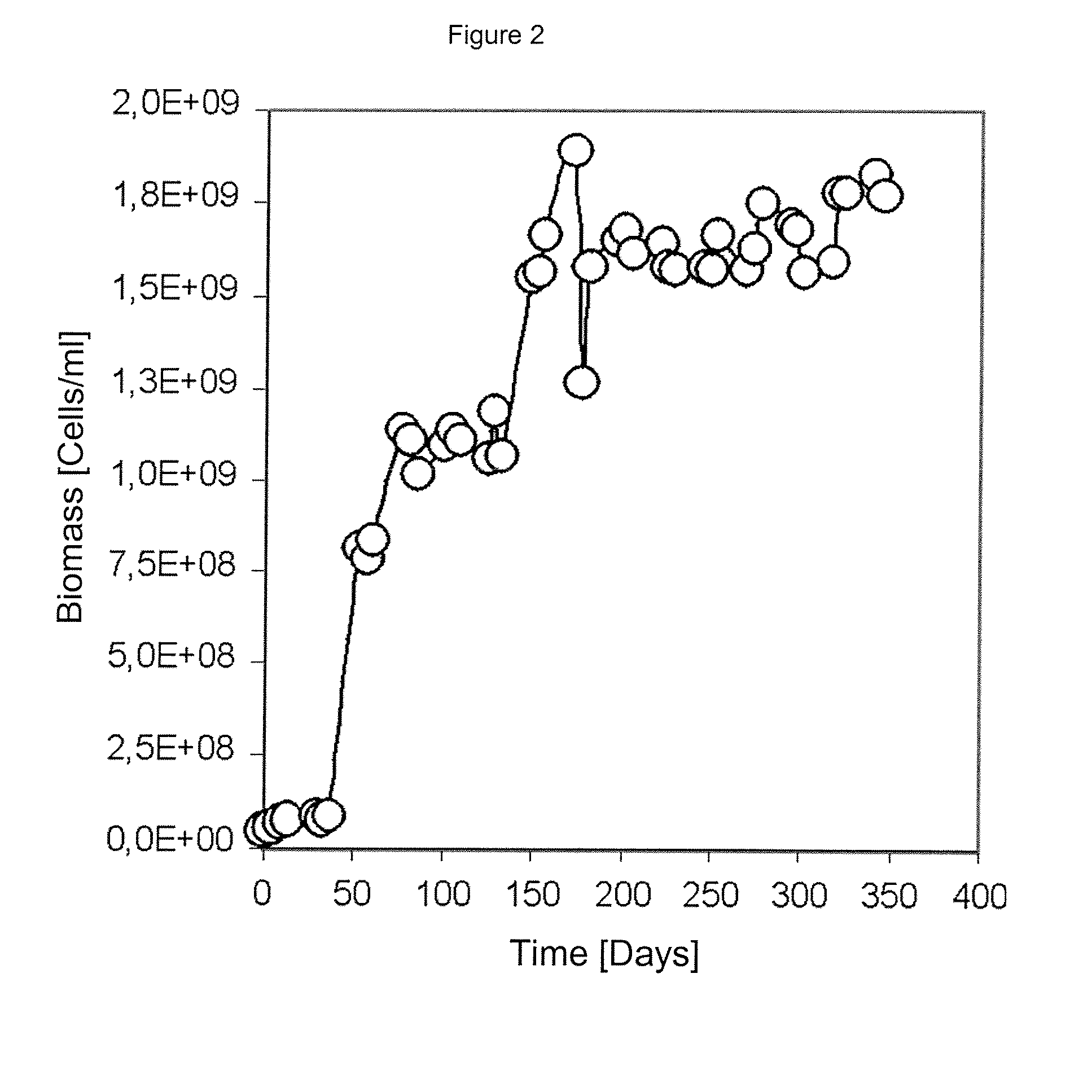PROCESS FOR THE JOINT CULTURE OF AN ASSOCIATION OF MICROORGANISM, USING PYRITE (FeS2) AS AND ENERGY SOURCE
a technology of microorganisms and energy sources, applied in the field of joint culture of an association of microorganisms, can solve problems such as impracticality
- Summary
- Abstract
- Description
- Claims
- Application Information
AI Technical Summary
Benefits of technology
Problems solved by technology
Method used
Image
Examples
example 1
RESULTS
[0060]As it can be observed in FIG. 1, adding pyrite concentrate (I) at concentration levels of 2 and 5 g / 1 makes it possible to increase the free biomass propagation rate and the final biomass title obtained in a medium with a 7.5 g / l initial ferrous sulfate concentration. Adding 10 g / L concentrate (I) makes only increasing the final title possible because of the delay in free biomass propagation probably due to the adsorption of cells on the solid surface. In the case of the 7.5 g / l ferrous sulfate +concentrate (I) 5 g / 1 mixture, it is possible to obtain more free-biomass in 6 days than with a culture medium without concentrate (I) and with a 1.5 g / l ferrous sulfate concentration. In other words, it is clearly established that it is possible to replace part of the ferrous sulfate of the medium with pyrite concentrate (I).
EXAMPLE 2
[0061]The following protocol is used to carry out an experiment with the purpose of determining growth kinetics and biomass performance of the Wen...
example 2
RESULTS
[0067]As it can be observed in FIG. 2, a rapid increase in microorganism concentration was produced in the culture medium modified with pyrite concentrate, and a maximum microorganism concentration of 1.7×109 cells / ml was reached in 6 days. Based on data obtained during the exponential growth phase, it was possible to determine a specific 0.069 h−1 growth rate.
EXAMPLE 3
[0068]An experiment is carried out with the purpose of demonstrating that the Wenelen DSM 16786 and Licanantay DSM 17318 microorganism association can be effectively propagated in a continuous manner using a medium modified with the incorporation of pyrite concentrate (III), using the following protocol.
Protocol
[0069]Bacterial growth was carried out in a 50 m3 reactor. The culture medium used in the propagation of the microorganisms was prepared by suspending pyrite concentrate (III) (at a 0.125% slurry density) in a nutrient solution composed of: 8 g FeSO4 / L, 0.99 g (NH4)2SO4 / L, 0.128 g NaH2PO4.H2O / L, 0.0525 g...
example 3
RESULTS
[0076]FIG. 3 shows that the continuous operation of a bioreactor, using a medium modified with the incorporation of pyrite concentrate, effectively permits the propagation of At. ferrooxidans and At. thiooxidans species
PUM
| Property | Measurement | Unit |
|---|---|---|
| temperature | aaaaa | aaaaa |
| temperature | aaaaa | aaaaa |
| culture temperature | aaaaa | aaaaa |
Abstract
Description
Claims
Application Information
 Login to View More
Login to View More - R&D Engineer
- R&D Manager
- IP Professional
- Industry Leading Data Capabilities
- Powerful AI technology
- Patent DNA Extraction
Browse by: Latest US Patents, China's latest patents, Technical Efficacy Thesaurus, Application Domain, Technology Topic, Popular Technical Reports.
© 2024 PatSnap. All rights reserved.Legal|Privacy policy|Modern Slavery Act Transparency Statement|Sitemap|About US| Contact US: help@patsnap.com










